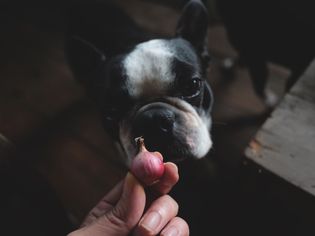During the summer, many dog owners enjoy taking their dogs to lakes, beaches, and rivers to give them a chance to cool off and flex their swimming muscles.
On these adventures, it’s important to keep an eye out for toxic cyanobacteria, sometimes called blue-green algae, that can quickly turn a fun adventure into a fatal accident. These bacteria are poisonous to dogs when touched or consumed, and they are especially common in the summer, when warm, sunny conditions promote accelerated growth. Some regions have issued warnings already this year.
The best way to keep your dogs safe this summer is to keep them away from any suspicious water. Here’s what else you need to know.
What Are Cyanobacteria?
Cyanobacteria are a type of photosynthetic bacteria that grow in water systems when they have access to nutrients such as phosphorus and nitrogen as well as sunlight and warm temperatures. When these bacteria grow in large quantities—known as a bloom—they can produce toxins that are dangerous to humans, dogs, and other animals. Technically, it's not algae.
“The exact toxins and the amounts that are produced is really a consequence of how much nutrient is in the water, what the growing conditions are, the temperature, the light, and so forth,” said Dr. David Caron, a microbiologist and professor at the University of Southern California.
It is most common for cyanobacteria blooms to form in lakes, ponds, and other bodies of still, fresh water, but they can also be found in salt water. The blooms often emerge at the edge of the water where it is especially warm and still, two conditions in which cyanobacteria thrive. They can occur throughout the United States.
Blooms can look like foam, scum, or mats floating on the surface of water, though they sometimes stay below the surface. They are often bright green but can appear blue, brown, and red. Not all cyanobacteria blooms are toxic, but it is impossible to tell by looking at it, according to the Centers for Disease Control and Prevention.
Dogs are especially susceptible to cyanobacteria poisoning because they often play and drink at the water’s edge and don’t know they should avoid any green, algae-like substances that may be floating on the surface.
“Though fatal poisoning is uncommon, the best thing concerned pet owners can do is keep an eye on their dogs when near wild water sources and prevent them from drinking standing water,” Sarah Hoggan, veterinarian and medical director of the VCA California Veterinary Specialists, said.
Signs and Symptoms of Cyanobacteria Poisoning
Cyanobacteria toxins can have different effects on dogs. Certain toxins can cause treatable symptoms, such as skin irritation or gastrointestinal irritation, while other toxins are much more dangerous and can cause severe neurological damage, liver failure, and even death.
“It really depends on the species of cyanobacteria,” Sarah Hoggan, veterinarian and medical director of the VCA California Veterinary Specialists facility in Murietta, California, said in an email interview. “Like any naturally occurring substance, like mushrooms, some species are more poisonous than others. In addition to the species, it also depends on the concentration of the cyanobacteria in the water.”
Symptoms appear within 60 minutes of exposure, often in under 30 minutes, according to Hoggan. Symptoms may include:
- Itching
- Redness
- Blisters
- Vomiting
- Diarrhea
- Tremors
- Convulsions
- Hypersalivation
- Watering eyes
- Uncontrolled urination
- Acute paralysis
- Trouble breathing
- Shock
What to Do if Your Dog Is Exposed
If you know or suspect your dog has consumed or come into contact with toxic cyanobacteria, it is important to get them to a veterinarian as soon as possible. Be prepared to share as many details as possible about the exposure—whether your dog touched the bacteria or consumed it, what the water looked like—to assist with diagnosis and treatment. You should use caution in handling your dog as people can also be at risk for skin irritation and other health problems from cyanobacteria. Wear gloves and wrap your dog in a blanket or towel before handling whenever possible.
Unfortunately, there is not much that can be done if the dog has come into contact with an extremely toxic strain of cyanobacteria. These cases most often result in death because fatal neurological damage or liver failure can occur quickly, even when a dog is taken to a vet immediately.
“If it is one of the poisonous strains that causes neurological or liver damage, recovery is not likely,” Hoggan said. “Sadly these cases, though rare, are most often fatal. If the species is one of the less poisonous species that causes painful irritation, the prognosis for recovery is better after treatment.”
How to Protect Your Dog
Because toxic cyanobacteria can be so dangerous, prevention is the best practice.
Do a thorough check of the water before letting your dog swim. Avoid any stagnant or dirty water, and never let them swim in or drink from water with a film on its surface, especially if it appears bright green, blue, brown, or red.
“Though fatal poisoning is uncommon, the best thing concerned pet owners can do is keep an eye on their dogs when near wild water sources and prevent them from drinking standing water,” Hoggan said. “Be prepared on hikes and walks by bringing more clean drinking water for your dog than you think you need. It is always better to be safe than sorry.”
You can also research the lake or water source you plan to visit in advance to see if cyanobacteria has been reported there. Each state and locality has its own system for tracking toxic cyanobacteria and algae blooms, so research what is available where you live.
For instance, several local governments across the country have already issued warnings about blue-green algae blooms this summer, including in Oklahoma, Colorado, Indiana, Maine, Kansas, Florida, and New Mexico. It can be almost anywhere.
If you suspect you’ve spotted a cyanobacteria bloom, take a photo and send it to your local department of environmental safety.
“You might be able to bring that to somebody’s attention and begin some monitoring,” Caron said.








